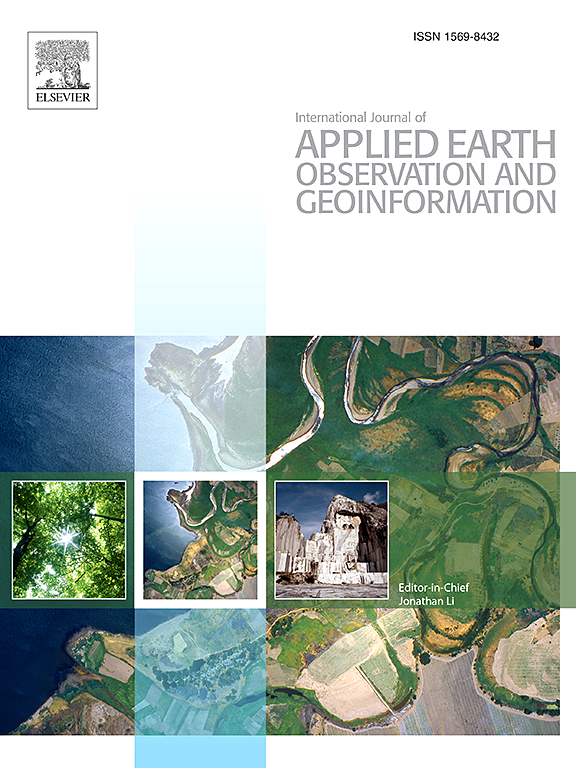HyperEst: Context-aware self-supervised pretraining for hyperspectral and multispectral water quality estimation
IF 8.6
Q1 REMOTE SENSING
International journal of applied earth observation and geoinformation : ITC journal
Pub Date : 2025-08-19
DOI:10.1016/j.jag.2025.104761
引用次数: 0
Abstract
Accurate retrieval of water quality parameters (WQPs) from remote sensing imagery is essential for large-scale aquatic monitoring. However, existing models often suffer from limited generalizability across diverse optical water types, reliance on scarce labeled data, and sensitivity to input variability from different sensors. This paper proposes HyperEst, a self-supervised learning (SSL) framework designed to overcome these challenges. The core of our framework is a novel universal context-aware autoencoder (UCAA), which is pretrained on vast unlabeled hyperspectral imagery using a unique single-pixel reconstruction strategy and a multi-scale diffusion loss to promote robust spectral-spatial feature learning. The pretrained UCAA acts as a strong prior, enhancing generalization to unseen areas and reducing outlier errors. Furthermore, we introduce the weighted mean improvement (WMI), a metric designed for a balanced performance assessment across multiple WQPs, including Chlorophyll-a, total suspended solids, and colored dissolved organic matter. Once fine-tuned, HyperEst achieves state-of-the-art performance. Our model improves by 1.87%–3.75% and reduces prediction bias by 26.24%–65.47% in terms of WMI. The experimental results highlight the scalability and robustness of HyperEst, representing a step forward in developing globally applicable models for water quality estimation from spaceborne observations.
HyperEst:用于高光谱和多光谱水质估计的上下文感知自监督预训练
从遥感影像中准确提取水质参数对大规模水体监测至关重要。然而,现有模型在不同光学水类型中的通用性有限,依赖于稀缺的标记数据,并且对来自不同传感器的输入可变性敏感。本文提出了HyperEst,一种旨在克服这些挑战的自监督学习(SSL)框架。我们的框架的核心是一种新型的通用上下文感知自编码器(UCAA),它使用独特的单像素重建策略和多尺度扩散损失对大量未标记的高光谱图像进行预训练,以促进鲁棒的光谱空间特征学习。预训练的UCAA作为一个强先验,增强了对未知区域的泛化并减少了异常值误差。此外,我们引入了加权平均改进(WMI),这是一种设计用于平衡多个wqp性能评估的指标,包括叶绿素-a、总悬浮固体和彩色溶解有机质。一旦微调,HyperEst达到了最先进的性能。在WMI方面,我们的模型将log2提高了1.87%-3.75%,将预测偏差降低了26.24%-65.47%。实验结果突出了HyperEst的可扩展性和鲁棒性,代表了在开发基于星载观测的全球适用的水质估计模型方面迈出了一步。
本文章由计算机程序翻译,如有差异,请以英文原文为准。
求助全文
约1分钟内获得全文
求助全文
来源期刊

International journal of applied earth observation and geoinformation : ITC journal
Global and Planetary Change, Management, Monitoring, Policy and Law, Earth-Surface Processes, Computers in Earth Sciences
CiteScore
12.00
自引率
0.00%
发文量
0
审稿时长
77 days
期刊介绍:
The International Journal of Applied Earth Observation and Geoinformation publishes original papers that utilize earth observation data for natural resource and environmental inventory and management. These data primarily originate from remote sensing platforms, including satellites and aircraft, supplemented by surface and subsurface measurements. Addressing natural resources such as forests, agricultural land, soils, and water, as well as environmental concerns like biodiversity, land degradation, and hazards, the journal explores conceptual and data-driven approaches. It covers geoinformation themes like capturing, databasing, visualization, interpretation, data quality, and spatial uncertainty.
 求助内容:
求助内容: 应助结果提醒方式:
应助结果提醒方式:


